For over 30 years, the Eurostar has been transporting travellers across Western Europe with its smooth, high-speed rail network links France, Belgium, the Netherlands, Germany, and the UK. However, if it is your first time taking the Eurostar, the process could be a bit confusing – booking tickets, understanding luggage policies, and the boarding protocols may seem daunting.
No need to worry! All you need is a little guidance to make your Eurostar planning as smooth as the journey itself This article walks you through everything you’ll need to know to prepare for when taking the Eurostar, meaning you’ll be able to confidently commute across Europe with one of the area’s most renowned providers with ease.
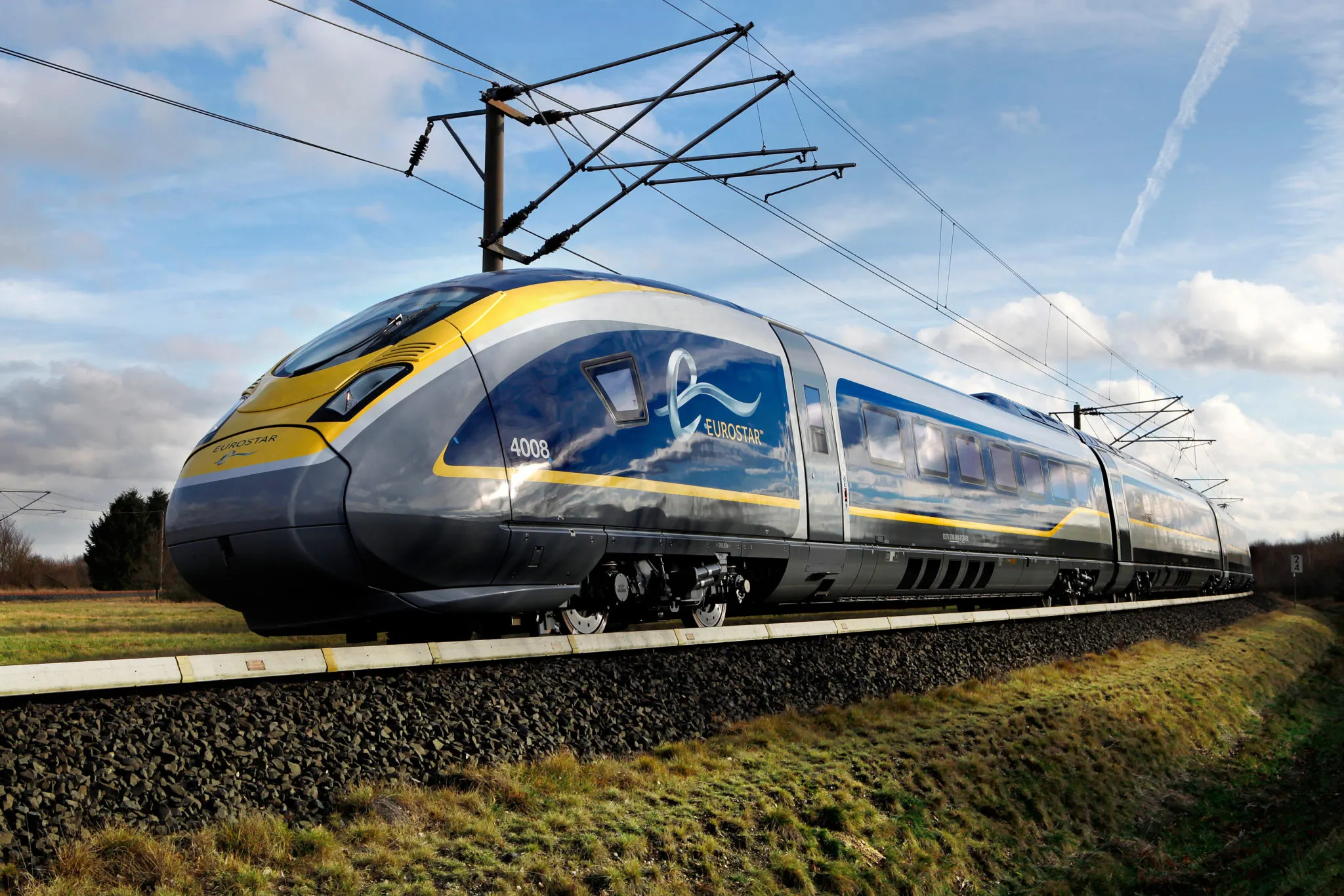
Image by Siemens AG - www.siemens.com/press
What is the Eurostar?
The Eurostar is a high-speed international train which can reach a speed of 300 km/h (186 mph), and connects major European cities, including London, Paris, Brussels, and Amsterdam. It operates through the Channel Tunnel (occasionally nicknamed the "Chunnel"), a rail tunnel owned by Getlink located beneath the English Channel, providing a fast and convenient alternative to flights.
Since its launch in 1994, Eurostar has transformed how people travel between the UK and mainland Europe. The service began with services between London, Paris, and Brussels, but has since expanded to include destinations like Amsterdam and seasonal routes to the French Alps.
An important milestone came in 2007 when the UK terminus moved to the newly refurbished St. Pancras International station, which helped further reduce travel times and cement its reputation. Another notable change was Eurostar’s 2022 merge with Thalys, a high-speed train service provider. Eurostar now operates along all of Thalys’ former routes (which can be easily identified as the trains still boast Thalys’ original, distinct red colour, compared to Eurostar’s grey-yellow).
Since its launch, Eurostar has become popular among both leisure and business travellers due to its comfort, efficiency, and eco-friendly initiatives. Often taken as an alternative to flying, the Eurostar offers no luggage weight or liquid capacity restrictions that you’ll find with airlines, and, when combined with spacious seats, onboard amenities, different classes of carriages and city-centre departures and arrivals, it’s no surprise it’s such a popular choice for travelling in Europe.
Step-by-step guide to taking the Eurostar
Travelling on the Eurostar for the first time may feel overwhelming, but a little preparation and the right information can make your journey both seamless and enjoyable. Once you’ve decided to travel via Eurostar, here are the key steps to follow:
Step 1: Book your tickets
Booking in advance can help ensure you get the best ticket prices, especially for peak times like the bank or Christmas holidays. Firstly, it’s helpful to understand how far in advance you can book the Eurostar.
| When are you looking to book your ticket? | What to expect for the London to Paris journey |
| 6–8 months in advance | Tickets for Eurostar trains between London and major destinations like Paris, Brussels, and Amsterdam are usually available at this time. Book early for the best prices and seat selection. |
| 3–6 months in advance | Tickets should be available for purchase at this time. If your journey includes onward connections from Paris, it’s a good idea to wait until those connecting trains open for booking. This ensures you can coordinate schedules before committing to a non-refundable Eurostar ticket. |
| Less than 3 months in advance | Tickets will be available at this time, but be weary that, as it’s closer to the date, they may have sold out. If your journey includes onward connections from Paris, wait until those trains open for booking to confirm your plans before committing to a non-refundable Eurostar ticket. Some dates or trains may still be unavailable in search results due to ongoing trackwork planning, so check back closer to your preferred travel date. |
After checking out the booking schedule, do the following:
- Use Trip.com: Start by using our search bar to enter your travel details, such as the departure city (e.g., London), destination (e.g., Paris), travel dates, and the number of passengers.
- Select your train: Browse the list of available trains, which includes key details like departure and arrival times, journey duration, and ticket prices. Choose a ticket class that suits your preferences, such as standard (more affordable), Standard Premier (offers space and a light meal), or Business Premier (offers luxury seats and lounge access).
- Complete the purchase: Enter passenger details, ensuring that the names match your passport or ID. Pay securely using your preferred method, and once your booking is confirmed, you will receive an e-ticket in-app.and via email.
Eurostar also offers flexible tickets that allow you to change your booking as many times as you want with no exchange fee up to one hour before departure. If the new ticket is more expensive, you'll need to pay the difference; if it's cheaper, no refund of the difference is provided. Tickets are refundable up to seven days before departure for a fee of £25/€25 per person, per leg of the journey. Within seven days of departure, tickets become non-refundable.
The tickets are often more affordable for trips scheduled between midday on Monday and midnight on Thursday. If your travel dates are flexible, opting for a mid-week journey instead of a weekend trip could help you save money.
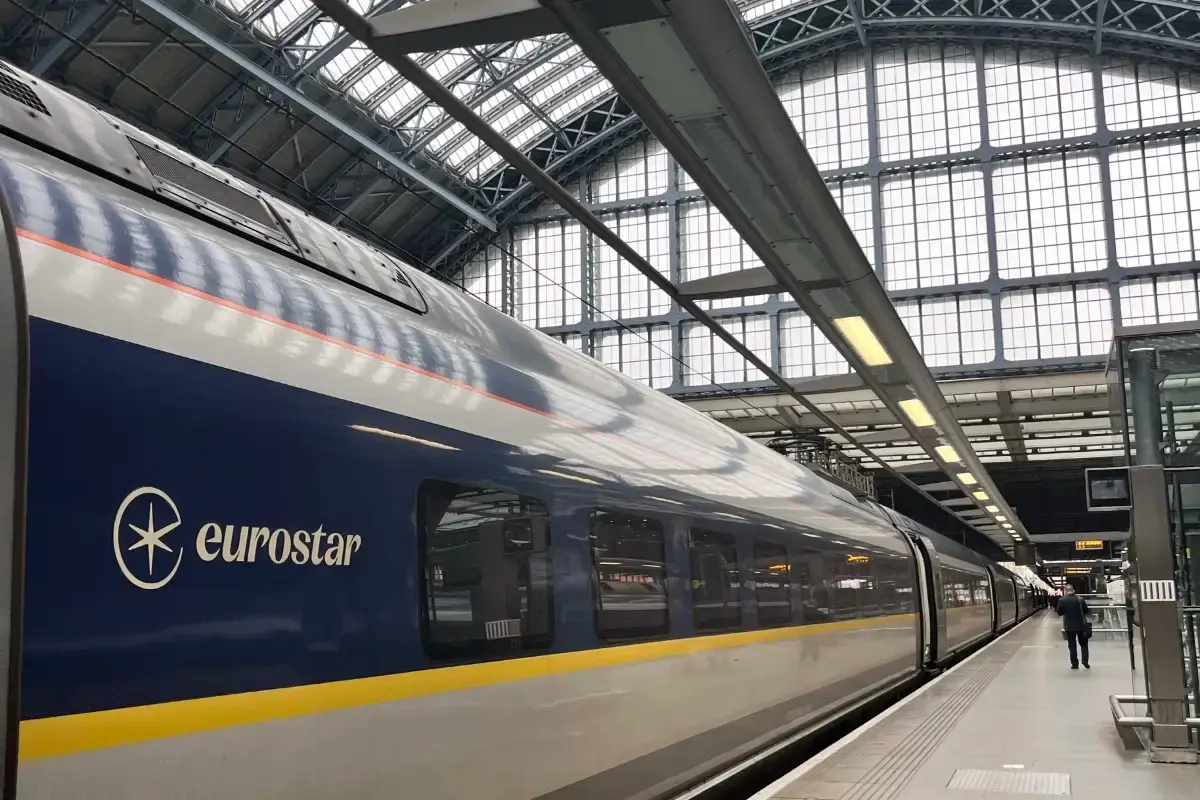
Step 2: Prepare for the journey
- Verify travel documents: Double-check that your passport or ID is valid for travel, and confirm whether you need a visa for your destination.
- Packing: Don’t forget to check Eurostar luggage restrictions. Typically, the train allows two bags and one small carry-on for Standard and Standard Premier tickets, with more for Business Premier passengers. Ensure to avoid oversized items or restricted goods.
- Arrival time: Plan to arrive at the station at least 90-120 minutes before departure to allow time for check-in, security, and boarding.
Step 3: Arrive at the station
- Arrival times: For Standard and Standard Premier tickets, it’s recommended to arrive 90 to 120 minutes before departure, as gates close 30 minutes before the train leaves. For Business Premier tickets, you can arrive slightly closer to departure (at your own risk!), as ticket gates close 15 minutes before the train leaves and dedicated priority lanes streamline the process.
- Finding the Eurostar terminal: Major Eurostar terminals include London St. Pancras International, Gare du Nord in Paris, and Brussels-Midi. Clear signage throughout these stations will direct you to the Eurostar departure areas.
- Check-in and security procedures: Upon arrival, either scan your e-ticket at the self-service machines or present it to Eurostar staff at the check-in gate.Passengers go through security checks similar to those at an airport, though there are no restrictions on carrying liquids. Complete exit checks for your departure country and entry checks for your destination. You’ll typically need to present your passport to both UK and French (or other Schengen) authorities before boarding.
Step 4: Boarding the Eurostar
- Check the departure board: Upon arrival at the station, keep an eye on the departure board. It will display your train number, departure time, and platform once the information is available. Announcements will also be made, so stay tuned for updates.
- Get onboard: When boarding begins (approximately 20 minutes before departure), proceed to the platform and locate your train car. Checking the Eurostar seating plan can help you find the details of your seat.
Step 5: Completing your journey
- Disembarking: Upon arrival, follow the signs to exit the station. Major terminals like Gare du Nord and Brussels-Midi are well-organized and provide clear directions for onward connections.
- Customs and immigration: Unlike airports, there’s no baggage claim, and customs checks are minimal for most travellers, so you’re free to go!
- Continue the journey: Local transport options, such as taxis, buses, and metro stations, will be conveniently located outside the terminal to help you reach your final destination. For instance, at Brussels-Midi/Zuid, you can easily transfer to local trains, trams, or the metro system.
Travelling on Eurostar can be an effortless process for those who stay vigilant and plan their trip efficiently. Both standard and first-class Eurostar travellers can have an impeccable experience, and this is what makes the trains famous!
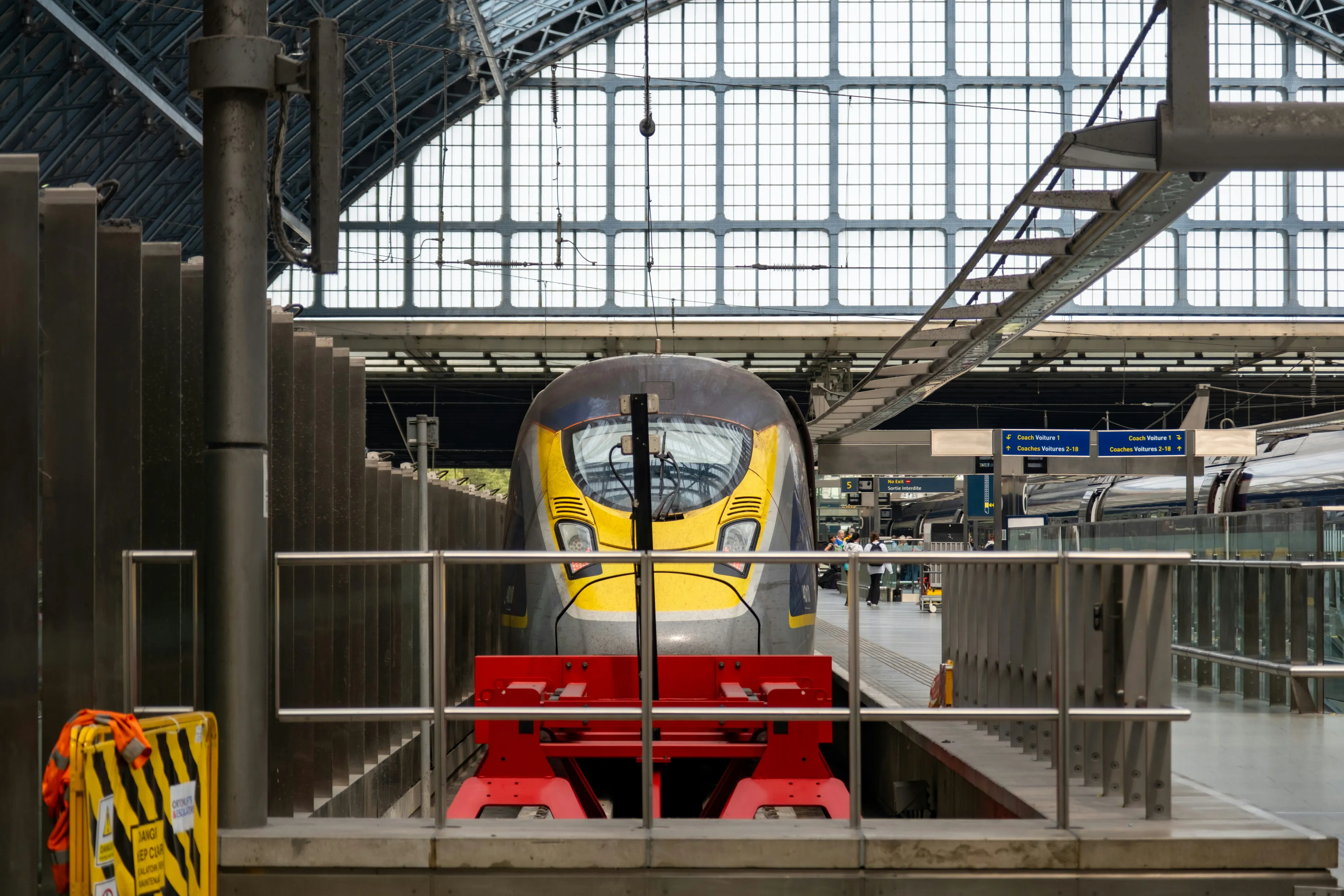
Tips for London to Paris Eurostar journey
Unlike flying, where you might need to travel to airports located outside the city, Eurostar takes you straight from the heart of London to central Paris, giving you more time to explore each city.
Travelling from London to Paris on the Eurostar is fast, comfortable, and convenient. The trip starts at St. Pancras station, where you can shop, eat at famous restaurants, or have a drink at Europe’s longest champagne bar. On the train, enjoy roomy seats, free Wi-Fi, and lovely views of the English countryside before passing through the Channel Tunnel.
At Gare du Nord, you will step right into the heart of Paris. The station is centrally located, making it easy to hop on public transport and visit famous landmarks like Notre Dame or the Champs-Élysées. Eurostar’s schedules and travel times make planning simple. With affordable tickets, reliable service, and a wide network, it’s the perfect way to explore Europe, especially the iconic London-to-Paris route.
As you prepare for your Eurostar journey from London St. Pancras to Paris Gare du Nord, it is helpful to know a few key details that can enhance your experience:
- Travel Time: The journey from London to Paris typically takes around 2 hours and 15 minutes, making it one of the fastest ways to travel between these two cities. Just think - you will spend more time enjoying the scenery and comfort of the train instead of waiting around at an airport.
- Comfort: Onboard, you can relax in spacious, comfortable seats with ample legroom, free Wi-Fi (for Business Premier and some Standard Premier passengers), and delicious food options. This ensures that your London to Paris journey is as pleasant as the destination itself.
How early should you arrive at the station for the Eurostar?
While Eurostar’s protocols aren’t as rigid as those for air travel, it’s important to plan your arrival carefully to ensure a smooth experience. Eurostar recommends arriving at least 90 minutes before departure, particularly for first-time travellers or during peak periods. This allows ample time to check in, pass through security, and complete both exit and entry passport controls without feeling rushed.
For travellers with Premier tickets (Standard Premier or Business Premier), Eurostar suggests arriving 45–60 minutes before departure, as the gate for these ticket holders closes 15 minutes before the train leaves.
Keep in mind Eurostar’s reputation for punctuality and strict boarding policies. Gates close 30 minutes before departure for Standard ticket holders and 15 minutes for Premier passengers. Arriving late could mean missing your train entirely.
Arriving early has other advantages, too:
- Familiarise yourself with the station: Major terminals like London St. Pancras International and Gare du Nord in Paris are bustling hubs. Clear signage makes navigation straightforward, but during busy times, the crowd can make the experience overwhelming. Arriving with extra time ensures you can locate your check-in gate and boarding platform easily.
- Explore amenities: Stations often feature cafes, shops, and other amenities. Use the extra time to grab a snack, browse duty-free shops, or even preview Eurostar’s onboard menu to plan your in-travel meal.
Where does the Eurostar go?
Spanning over multiple countries, the Eurostar connects to some of Europe’s most iconic destinations. From the busy London streets to romantic Paris and charming Amsterdam, Eurostar continues to provide an unforgettable travel experience to all.
Here is a helpful map from the Eurostar website as a visual display of the routes the service takes:
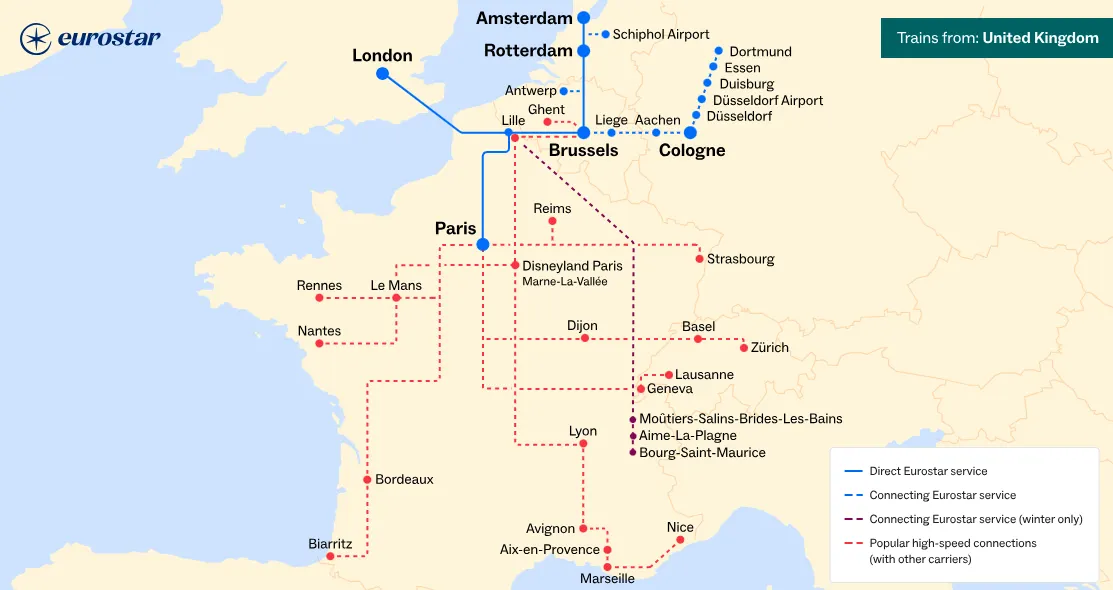
Below, we have listed a breakdown of the destinations you can access directly or indirectly through Eurostar.
United Kingdom
The Eurostar departs from London St. Pancras International, a central hub for travellers in the UK. St. Pancras is well-connected to local and national rail services, making it an ideal starting point for journeys to Europe.
France
France is a major destination on the Eurostar route, with key stops including:
- Paris Gare du Nord: The heart of the French capital, offering easy access to world-famous landmarks like the Eiffel Tower and the Louvre.
- Lille Europe: A northern gem perfect for quick getaways and connections to other French cities.
- Marne-la-Vallée – Chessy: Convenient for Disneyland Paris visitors.
Belgium
The Eurostar train stops at Brussels South Station, the capital of Belgium. This is a central station for exploring Brussels’ historic squares and connecting to other Belgian cities like Bruges and Antwerp.
Netherlands
It only takes about 4 hours from London to reach the Netherlands via Eurostar. The train stops at Rotterdam Central Station and Amsterdam Central Station, one after the other. Currently, Eurostar doesn’t go to Switzerland. There are no routes from Paris to Switzerland or from London to Switzerland.
Indirect Access to Germany
The Eurostar doesn’t travel directly to Germany but offers easy connections. From Brussels-Midi/Zuid, you can take Deutsche Bahn trains to cities like Cologne, Frankfurt, and Berlin. From Paris Gare du Nord, you can connect with high-speed trains to reach other destinations in Germany.
Eurostar Seating Plan
Eurostar offers a range of seating options which cater to varying travel preferences and budgets. Whilst some people may look for affordable but quick travel, others want a premium travel experience - Eurostar offer a seating class for everyone.
Note that the layout varies slightly depending on the train model (e320 or e300), but all classes provide spacious seating, modern amenities, and a smooth ride through Europe.
Below is a breakdown of available travel classes and their features:
Eurostar Standard
Perfect for budget-conscious travellers, offering comfortable seats with good legroom and adjustable headrests. You can buy snacks and drinks from the onboard café bar. Free Wi-Fi and digital magazines are also available to keep you entertained.
Eurostar Plus
Upgrading to Eurostar Plus offers extra space and comfort without the full premium price. Passengers enjoy priority boarding, access to Eurostar lounges at select stations, and complimentary snacks and drinks.
Eurostar Business Premier
Business Premier class offers extra-wide seats with plenty of space for work or relaxation. Enjoy a gourmet three-course meal with fine wine or champagne and access premium lounges with refreshments and business facilities. Or, choose to benefit from unlimited ticket flexibility and fast-track security for a stress-free journey.
What is the difference between e300 and e320 trains?
- e300 Trains: These are the original Eurostar trains, also known as Class 373. They have been refurbished to offer comfortable seating and modern amenities. The seating arrangement includes both Standard and Premier classes, with Standard class located in coaches 1–5 and 13–18, and Business Premier/Standard Premier seats in coaches 7–12.
- e320 Trains: The newer addition to the Eurostar fleet, also known as Class 374. These trains feature a sleeker design, upgraded seating, and additional amenities like larger luggage racks and more spacious interiors. The seating configuration differs from the e300, with Business Premier/Standard Premier seats located in coaches 1–3 and 14–16, and Standard class in coaches 4–7 and 10–13.
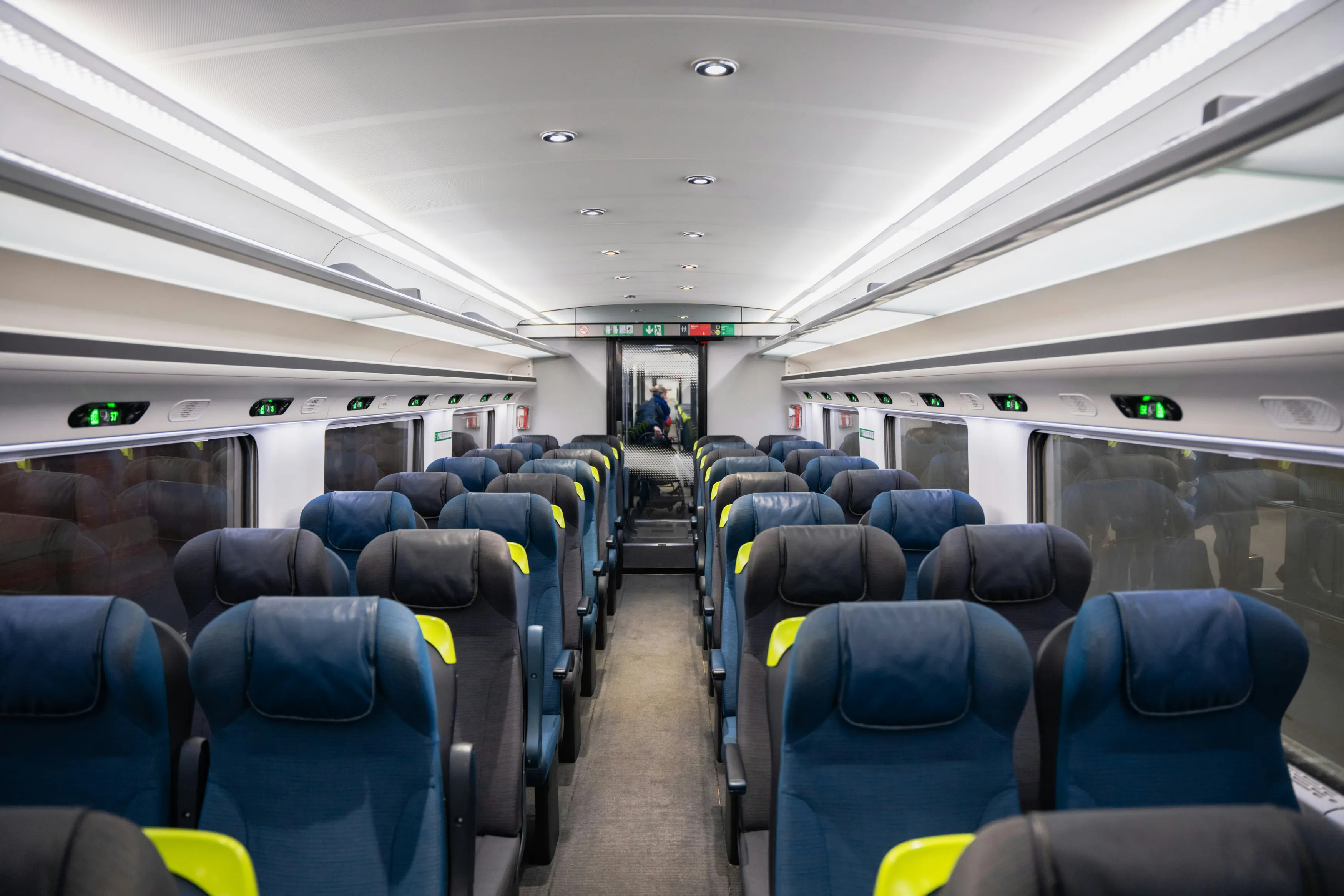
How fast does the Eurostar go?
We probably don’t need to tell you that the Eurostar is renowned for its high-speed. In fact, it’s what makes it one of the fastest ways to travel between the UK and mainland Europe.
How fast the Eurostar can go depends on the model. Whilst the e300 models reach speeds of 186 mph (300 km/h) on some parts of the route, the newer e320 trains, introduced in 2015, are faster, reaching around 200 mph (320 km/h).
For example, a trip from London to Paris only takes about 2 hours 15 minutes, with the train passing through the Channel Tunnel. Travelling from London to Brussels takes just two hours, and the journey from London to Amsterdam is around four hours. These fast connections make Eurostar a popular choice for both business travellers and tourists.
Eurostar Luggage Restrictions & Security
Just like air travel protocols, there are some strict policies for travelling via Eurostar, and the luggage restrictions should be followed if you want to prevent penalties or cancellations. The key travel guidelines include:
- Luggage allowance: Each passenger can bring two standard-sized bags (up to 85 cm in length) and one small carry-on (up to 45 cm x 36 cm x 20 cm).
- Permitted items: Suitcases, backpacks, and small bags are allowed.
- Not allowed: Oversized items or anything that could block aisles.
- Special items: For large items like bicycles or sports equipment, extra fees apply. Check the Eurostar website for details.
Before boarding, passengers will need to go through security screening, where bags will be x-rayed. These protocols are the reason why arriving 90 minutes before train departure is often advised. It allows time for security checks and avoids missing the trains.
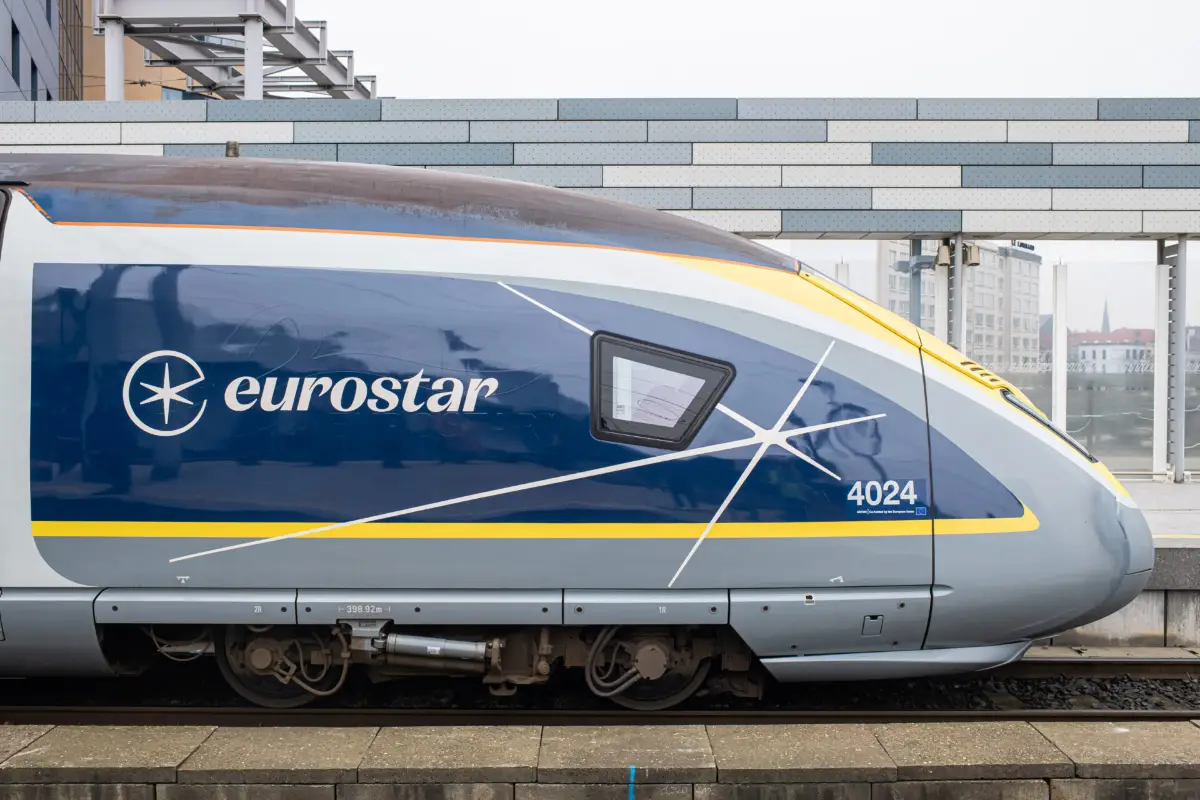
Eurostar food and drinks menu
Great news - there are several food and drink options when travelling on Eurostar, ranging from a light snack to a full meal, ensuring you stay refreshed and satisfied throughout your journey.
Refreshments are available for purchase in Eurostar Standard, while passengers in Standard Premier and Business Premier enjoy complimentary meals and drinks tailored to their ticket class. Here’s a more in-depth breakdown of what you can expect in each class:
Eurostar Standard food & drink
In this class, passengers can visit the café-bar for snacks, drinks, and light meals. Drink options include coffee, tea, soft drinks, wine, and beer. Snacks like pastries, sandwiches, and crisps are available, along with light meals such as salads and wraps.
Eurostar Plus food & drink
In Standard Premier, you can enjoy complimentary light meals served to your seat, including cold meals like salads, sandwiches, or deli platters. You can choose from coffee, tea, or herbal drinks, along with water, juices, and wine. Sweet treats like pastries or light desserts are also offered. Plus, you will receive priority boarding for a smoother travel experience.
Eurostar Premium dining
Business Premier offers the most luxurious onboard dining experience. Passengers enjoy a full three-course meal, served at their seat, with a choice of starters, mains, and desserts. Beverages include fine wines, champagne, soft drinks, and hot drinks. Throughout the journey, passengers are also offered luxurious snacks like artisanal chocolates.
Don’t forget to check the Eurostar website for more info on the full menu for each class.
How far in advance can you book the eurostar?
You can book Eurostar tickets 120 to 180 days in advance. If you’re planning to travel during peak periods, such as holiday seasons, it’s a good idea to start looking for tickets 4–6 months ahead. Tickets are released in stages, so checking early gives you the best chance of securing affordable options.It’s recommended to book early, as prices tend to rise closer to the travel date.
However, if you need to travel at short notice, you can also purchase tickets at the station. Keep in mind that popular routes, like those to Paris, Brussels, and Amsterdam, often open for booking earlier, while other routes may be available closer to the departure date.
Ready to book your Eurostar tickets? Use Trip.com to browse schedules and purchase your tickets today for a smooth and seamless travel experience!
How to change my Eurostar booking
No need to worry! Changing your Eurostar booking is straightforward, but it depends on the type of ticket you’ve purchased.
- Flexible tickets: If you’ve booked a flexible ticket, you can modify your travel dates or times without incurring extra charges, subject to availability.
- Non-refundable tickets: For non-refundable tickets, changes may not be possible, or they may incur a fee.
To modify your booking, simply visit the ‘My Bookings’ section on the Trip.com app or website. Here, you can view your current reservations and explore available options for changing your trip.
Be sure to check the terms and conditions of your ticket, as change policies can vary. If you need assistance, you can contact Trip.com customer support for help with adjustments or to inquire about other available options.
Do you need a passport for the Eurostar?
The short answer is – yes, you need a valid passport to travel on Eurostar. This is because you are crossing international borders, such as between the UK and France or Belgium. Depending on your nationality and destination, you may also need a visa.
- EU citizens: If you’re traveling within the Schengen Area (e.g., from Paris to Brussels or Amsterdam), you can use an ID card instead of a passport.
- UK or non-EU citizens: If you are traveling from the UK or outside the EU, a passport is generally required. Always check the entry requirements for your destination before you travel.
For London-to-Paris travellers, passport control is an essential step before boarding. At London St. Pancras International, passengers must clear both UK exit checks and French border controls. The process is typically quick, but arriving at least 90 minutes before departure ensures you have plenty of time to complete these checks.
Once you arrive at Gare du Nord in Paris, no further checks are necessary, as you have already cleared immigration. This streamlined process makes the London-to-Paris Eurostar journey not only efficient but also stress-free.
